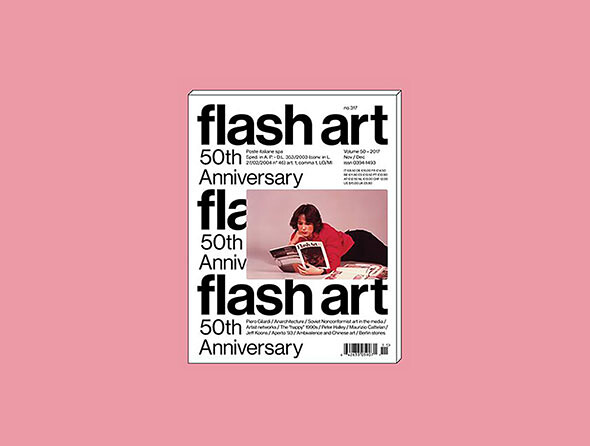November–December 2017
“April 1967. Rome, Via Fontana Liri, 27. In a suburban apartment Flash Art is born, the fruit of wild ideas, impossible-seeming dreams and obsessive lucubrations, all shared with a group of frustrated artists and critics just like us.”
–Giancarlo Politi and Helena Kontova, founders
We are pleased to announce that the November–December issue of Flash Art International is out now. This issue celebrates the 50th anniversary of the magazine. It features texts and interviews that reassess key passages in recent art history, in each case using landmark content from Flash Art‘s archive as a point of departure.
In this issue
In 1967 and 1968, Flash Art published Piero Gilardi‘s diary of his travels between the United States and Northern Europe. In reassessing those texts, Marco Scotini reveals the significant role that Gilardi played in promoting the emergence of the post-Minimalist, poverista and conceptual art tendencies of the 1960s.
In 1974, Anarchitecture, a group whose members included Gordon Matta-Clark and others connected to the artist-run gallery 112 Green Street, contributed a photo-essay to Flash Art, among the very few traces of their production. In the course of revisiting these images, Frances Richard revives the group’s debate about spatiality, sculpture and resistance.
In 1977, Flash Art featured a survey of “non-aligned” Russian artists. Throughout the 1980s, the magazine continued to report on the phenomenon of Soviet Nonconformist art, mainly through the criticism of Russian expats Victor and Margarita Tupitsyn. Gathered in conversation, Boris Klyushnikov, Alexandra Novozhenova and Andrey Shental reinterpret the emergence of those experiences not in spite of but thanks to the identity of the Soviet political system.
Jeff Koons was first featured on the cover of an art magazine in the February – March 1987 issue of Flash Art. The same issue featured an extended interview with Koons by Flash Art‘s founder Giancarlo Politi and other staff members. Here, Maurizio Cattelan engages Koons in one of his tongue-in-cheek interviews—a practice also inaugurated in the pages of Flash Art.
During the early 1980s, Jeffrey Deitch wrote a regular column for Flash Art called “Art and Money.” One such column—titled “Who Has the Power?”—specifically explored how art-world success is dependent on artist networks. Dena Yago reappraises Deitch’s argument by reflecting on how collective memory is enacted and recorded.
Peter Halley has been among Flash Art‘s most celebrated artists, with a formidable career that the magazine has followed closely since the mid-1980s. Not only an accomplished painter but also an incisive theorist, here Halley compiles a selection of his writings from the decade when digital technology conquered the world.
Eric Troncy‘s text “Being Positive is the Secret of the 90s,” which appeared in Flash Art in 1992, focuses on what the author sees as a tendency toward stifling moralization in art’s reception at the beginning of the 1990s. Eli Diner rereads Troncy’s text through the lens of some recent art-world controversies.
Aperto ’93, curated by Flash Art editor Helena Kontova and twelve other critics and curators active with the magazine, was an unprecedented rhizomatic exhibition that brought the polyphony of the globalized world into the context of the Venice Biennale. Kontova revisits the exhibition in dialogue with Hans Ulrich Obrist.
In 1994, Maurizio Cattelan was featured on the cover of Flash Art for the first time. This was followed by eleven subsequent covers, more than any other artist in the history of the magazine. Marco Senaldi analyses the strategic proliferation and canny mediation of Cattelan’s bold imagery.
“Ambivalent Witnesses,” Hou Hanru‘s survey of Chinese contemporary art published in Flash Art in 1996, was among the first attempts at framing this burgeoning scene. Twenty years after that publication, with China now a fully active participant in the globalized world, Weng Xiaoyu sifts through the dilemmas that still haunt the identity of Chinese art.
On the occasion of the first Berlin Biennale, Flash Art edited a portfolio of texts celebrating Berlin as an art city at the nexus of space, dynamism and futurity. In the aftermath of the 9th Berlin Biennale’s underscoring of the surrender of the city’s creative capital to capitalism, Tess Edmonson asks what’s left of “the Berlin Myth.”
In Reviews
Meriem Bennani at The Kitchen, New York; John Ahearn and Rigoberto Torres at Alexander and Bonin, New York; Senga Nengudi at the DePaul Museum, Chicago; Franklin Williams at Parker, Los Angeles; Elaine Cameron-Weir at Hannah Hoffmann, Los Angeles; José Antonio Suárez Londoño and Santiago de Paoli at Lulu, Mexico City; Jesse Reaves and Bradley Kronz at the Dorich House Museum, London; TJ Wilcox at Sadie Coles, London; Sophie Dupont at Overgaden, Copenhagen; Art Without Death: Russian Cosmism at the Haus der Kulturen der Welt, Berlin; Sergej Jensen at Neu, Berlin; John Russell at Kunsthalle Zurich; Daxter Dalwood at Hubert Winter, Vienna; Beatriz Olabarrieta at Antoine Levi, Paris; Lucio Fontana at Pirelli HangarBicocca, Milan; Windows at Jhaveri Contemporary, Mumbai; Wang Gongxin at White Cube, London; Rika Noguchi at Taka Ishii, Tokyo.
Finally, we are pleased to announce Flash Art’s participation in the 2017 editions of Paris Photo; West Bund, Shanghai; and Art Basel Miami Beach.

